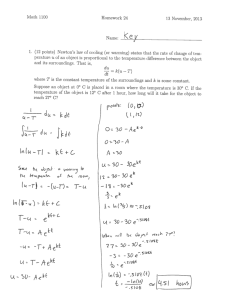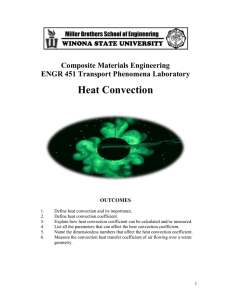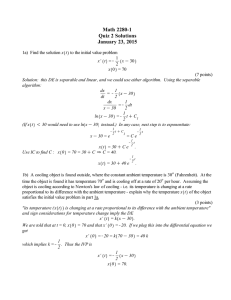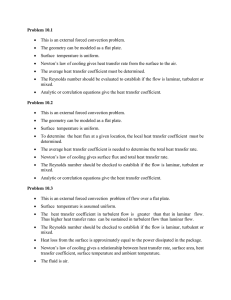Problem 1.1 applicable.
advertisement
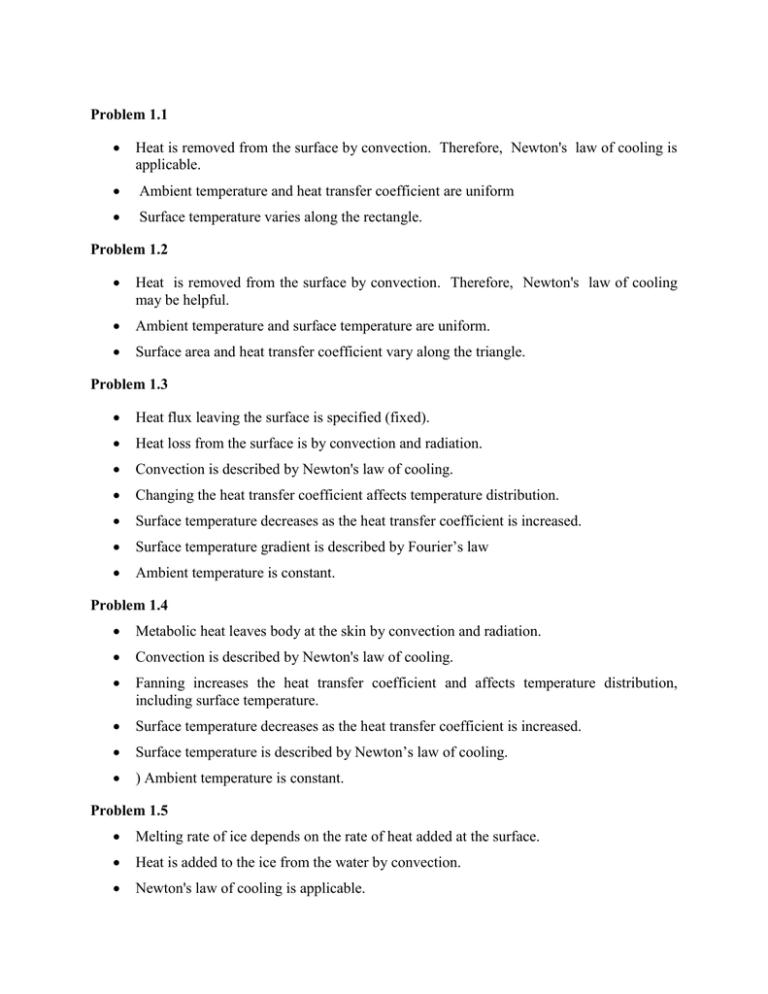
Problem 1.1 Heat is removed from the surface by convection. Therefore, Newton's law of cooling is applicable. Ambient temperature and heat transfer coefficient are uniform Surface temperature varies along the rectangle. Problem 1.2 Heat is removed from the surface by convection. Therefore, Newton's law of cooling may be helpful. Ambient temperature and surface temperature are uniform. Surface area and heat transfer coefficient vary along the triangle. Problem 1.3 Heat flux leaving the surface is specified (fixed). Heat loss from the surface is by convection and radiation. Convection is described by Newton's law of cooling. Changing the heat transfer coefficient affects temperature distribution. Surface temperature decreases as the heat transfer coefficient is increased. Surface temperature gradient is described by Fourier’s law Ambient temperature is constant. Problem 1.4 Metabolic heat leaves body at the skin by convection and radiation. Convection is described by Newton's law of cooling. Fanning increases the heat transfer coefficient and affects temperature distribution, including surface temperature. Surface temperature decreases as the heat transfer coefficient is increased. Surface temperature is described by Newton’s law of cooling. ) Ambient temperature is constant. Problem 1.5 Melting rate of ice depends on the rate of heat added at the surface. Heat is added to the ice from the water by convection. Newton's law of cooling is applicable. Stirring increases surface temperature gradient and the heat transfer coefficient. An increase in gradient or h increases the rate of heat transfer. Surface temperature remains constant equal to the melting temperature of ice. Water temperature is constant. Problem 1.6 This problem is described by cylindrical coordinates. For parallel streamlines vr v 0 . Axial velocity is independent of axial and angular distance. Problem 1.7 This problem is described by cylindrical coordinates. Streamlines are concentric circles. Thus the velocity component in the radial direction vanishes ( vr 0 ). For one-dimensional flow there is no motion in the z-direction ( v z 0 ). The -velocity component, v , depends on distance r and time t. Problem 1.8 This problem is described by Cartesian coordinates. For parallel streamlines the y-velocity component v 0 . For one-dimensional flow there is no motion in the z-direction (w = 0). The x-velocity component depends on distance y and time t. Problem 1.9 This problem is described by Cartesian coordinates. For parallel streamlines the y-velocity component v 0 . For one-dimensional flow there is no motion in the z-direction (w = 0). The x-velocity component depends on distance y only. Problem 1.10 Heat flux leaving the surface is specified (fixed). Heat loss from the surface is by convection and radiation Convection is described by Newton's law of cooling. Changing the heat transfer coefficient affects temperature distribution. Surface temperature decreases as the heat transfer coefficient is increased. Surface temperature gradient is described by Fourier’s law Ambient temperature is constant. Problem 1.11 Heat is removed from the surface by convection. Therefore, Newton's law of cooling is applicable. Ambient temperature and heat transfer coefficient are uniform. Surface temperature varies along the area. The area varies with distance x.
